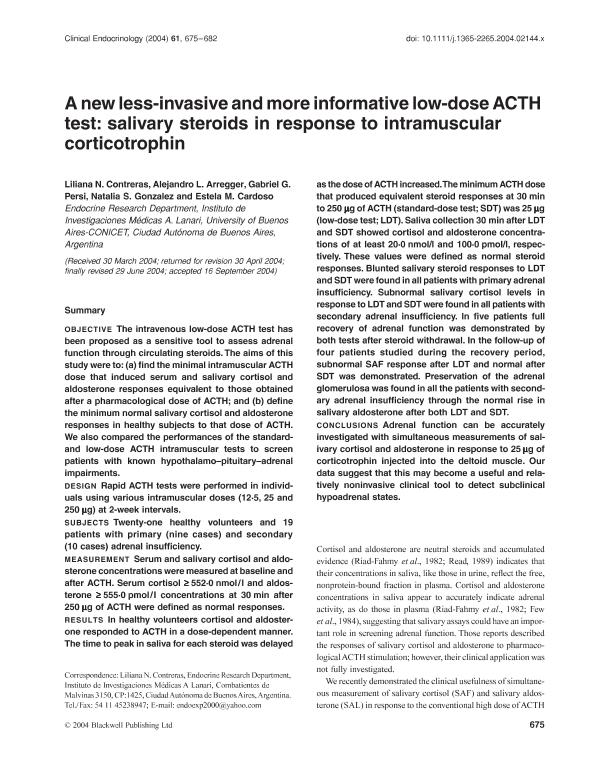Mostrar el registro sencillo del ítem
dc.contributor.author
Contreras, Liliana Noemí

dc.contributor.author
Arregger, Alejandro Luis

dc.contributor.author
Persi, Gabriel

dc.contributor.author
Gonzalez, Soledad Natalia

dc.contributor.author
Cardoso, Estela M. del Luján

dc.date.available
2020-06-29T20:39:56Z
dc.date.issued
2004-12
dc.identifier.citation
Contreras, Liliana Noemí; Arregger, Alejandro Luis; Persi, Gabriel; Gonzalez, Soledad Natalia; Cardoso, Estela M. del Luján; A new less-invasive and more informative low-dose ACTH test: salivary steroids in response to intramuscular corticotrophin; Wiley Blackwell Publishing, Inc; Clinical Endocrinology; 61; 6; 12-2004; 675-682
dc.identifier.issn
0300-0664
dc.identifier.uri
http://hdl.handle.net/11336/108441
dc.description.abstract
Objective: The intravenous low‐dose ACTH test has been proposed as a sensitive tool to assess adrenal function through circulating steroids. The aims of this study were to: (a) find the minimal intramuscular ACTH dose that induced serum and salivary cortisol and aldosterone responses equivalent to those obtained after a pharmacological dose of ACTH; and (b) define the minimum normal salivary cortisol and aldosterone responses in healthy subjects to that dose of ACTH. We also compared the performances of the standard‐ and low‐dose ACTH intramuscular tests to screen patients with known hypothalamo–pituitary–adrenal impairments. Design: Rapid ACTH tests were performed in individuals using various intramuscular doses (12·5, 25 and 250 µg) at 2‐week intervals. Subjects: Twenty‐one healthy volunteers and 19 patients with primary (nine cases) and secondary (10 cases) adrenal insufficiency. Measurement: Serum and salivary cortisol and aldosterone concentrations were measured at baseline and after ACTH. Serum cortisol ≥ 552·0 nmol/l and aldosterone ≥ 555·0 pmol/l concentrations at 30 min after 250 µg of ACTH were defined as normal responses. Results: In healthy volunteers cortisol and aldosterone responded to ACTH in a dose‐dependent manner. The time to peak in saliva for each steroid was delayed as the dose of ACTH increased. The minimum ACTH dose that produced equivalent steroid responses at 30 min to 250 µg of ACTH (standard‐dose test; SDT) was 25 µg (low‐dose test; LDT). Saliva collection 30 min after LDT and SDT showed cortisol and aldosterone concentrations of at least 20·0 nmol/l and 100·0 pmol/l, respectively. These values were defined as normal steroid responses. Blunted salivary steroid responses to LDT and SDT were found in all patients with primary adrenal insufficiency. Subnormal salivary cortisol levels in response to LDT and SDT were found in all patients with secondary adrenal insufficiency. In five patients full recovery of adrenal function was demonstrated by both tests after steroid withdrawal. In the follow‐up of four patients studied during the recovery period, subnormal SAF response after LDT and normal after SDT was demonstrated. Preservation of the adrenal glomerulosa was found in all the patients with secondary adrenal insufficiency through the normal rise in salivary aldosterone after both LDT and SDT. Conclusions: Adrenal function can be accurately investigated with simultaneous measurements of salivary cortisol and aldosterone in response to 25 µg of corticotrophin injected into the deltoid muscle. Our data suggest that this may become a useful and relatively noninvasive clinical tool to detect subclinical hypoadrenal states.
dc.format
application/pdf
dc.language.iso
eng
dc.publisher
Wiley Blackwell Publishing, Inc

dc.rights
info:eu-repo/semantics/openAccess
dc.rights.uri
https://creativecommons.org/licenses/by-nc-sa/2.5/ar/
dc.subject
Low-dose ACTH test
dc.subject
salivary cortisol
dc.subject
salivary aldosterone
dc.subject.classification
Medicina General e Interna

dc.subject.classification
Medicina Clínica

dc.subject.classification
CIENCIAS MÉDICAS Y DE LA SALUD

dc.title
A new less-invasive and more informative low-dose ACTH test: salivary steroids in response to intramuscular corticotrophin
dc.type
info:eu-repo/semantics/article
dc.type
info:ar-repo/semantics/artículo
dc.type
info:eu-repo/semantics/publishedVersion
dc.date.updated
2020-06-23T14:53:16Z
dc.journal.volume
61
dc.journal.number
6
dc.journal.pagination
675-682
dc.journal.pais
Reino Unido

dc.journal.ciudad
Londres
dc.description.fil
Fil: Contreras, Liliana Noemí. Consejo Nacional de Investigaciones Científicas y Técnicas. Oficina de Coordinación Administrativa Houssay. Instituto de Investigaciones Médicas. Universidad de Buenos Aires. Facultad de Medicina. Instituto de Investigaciones Médicas; Argentina
dc.description.fil
Fil: Arregger, Alejandro Luis. Consejo Nacional de Investigaciones Científicas y Técnicas. Oficina de Coordinación Administrativa Houssay. Instituto de Investigaciones Médicas. Universidad de Buenos Aires. Facultad de Medicina. Instituto de Investigaciones Médicas; Argentina
dc.description.fil
Fil: Persi, Gabriel. Universidad de Buenos Aires. Facultad de Medicina. Instituto de Investigaciones Médicas; Argentina
dc.description.fil
Fil: Gonzalez, Soledad Natalia. Consejo Nacional de Investigaciones Científicas y Técnicas. Oficina de Coordinación Administrativa Houssay. Instituto de Investigaciones Médicas. Universidad de Buenos Aires. Facultad de Medicina. Instituto de Investigaciones Médicas; Argentina
dc.description.fil
Fil: Cardoso, Estela M. del Luján. Consejo Nacional de Investigaciones Científicas y Técnicas. Oficina de Coordinación Administrativa Houssay. Instituto de Investigaciones Médicas. Universidad de Buenos Aires. Facultad de Medicina. Instituto de Investigaciones Médicas; Argentina
dc.journal.title
Clinical Endocrinology

dc.relation.alternativeid
info:eu-repo/semantics/altIdentifier/url/https://onlinelibrary.wiley.com/doi/abs/10.1111/j.1365-2265.2004.02144.x
dc.relation.alternativeid
info:eu-repo/semantics/altIdentifier/doi/https://doi.org/10.1111/j.1365-2265.2004.02144.x
Archivos asociados
